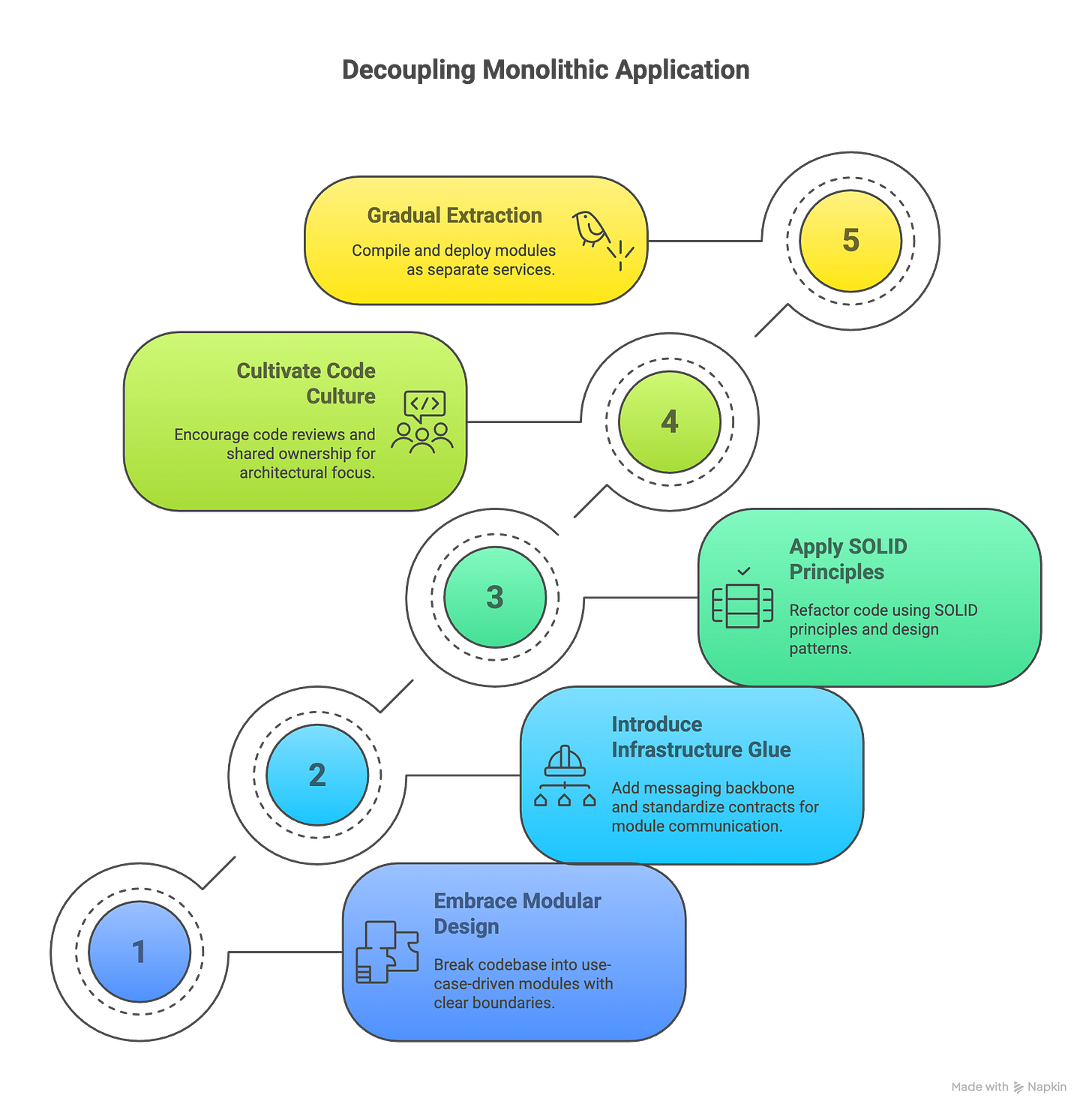Decoupling Your Monolithic Application: A Practical Guide for Software Engineers
5 aspects for a healthy monolith
Monoliths get a bad rap, and for good reason. When we picture legacy web apps from the ’90s (think sprawling PHP codebases), we imagine:
Tangled code
No clear separation of concerns
And a tendency to break every time you dared to touch one line.
☝🏼 But let’s be honest: the real culprit wasn’t PHP or Java or whatever language you used. It was we, developers, who skipped solid architecture principles, ignored design patterns, and treated code as disposable.
Software is alive, a living organism that grows, evolves, and sometimes decays, software is alive.
So, how do we turn that unwieldy monolith into a maintainable, scalable system?
Do you like what you read? Share it with your friends via 👇🏻
In today’s issue, I share with you the 5 key steps I’ve learned (the hard way) over two decades in software engineering to have a scalable monolithic application.
Yes, it’s possible to have a monolith that actually scales. Let’s get started.
1. Embrace Modular Design
At the heart of every decoupling effort is modularity. Break your codebase into use-case–driven modules rather than by technical layers.
Identify core use cases. For example, suppose your app receives user messages, forwards them to an LLM (large language model) for processing, and then persists the responses in S3. Instead of one giant “MessageProcessor” class, carve out:
Input Handler: Receives messages and enqueues them.
LLM Service: Dequeues messages, calls the LLM API, and publishes responses.
Persistence Service: Listens for LLM responses and writes them to S3.
Enforce clear boundaries. Each module owns its own data models and business logic. Communicate only through well-defined interfaces (APIs, message schemas, domain events).
By modeling around behaviour (use cases) instead of CRUD operations or framework constraints, you avoid the “God class” syndrome and set the stage for gradual extraction.
2. Introduce Infrastructure Glue
I’ve seen on many occasions that monoliths are tightly coupled because everything shares the same process and database.
To decouple modules:
Add a messaging backbone. Whether it’s Kafka, RabbitMQ, or even a simple SQS queue, a broker lets modules talk asynchronously. In our example, the Input Handler pushes messages to a queue; the LLM Service consumes them and, upon completion, emits events to another queue.
Standardize on contracts. Define message formats (JSON schemas, Protobuf, Avro) and version them. This prevents downstream chaos when the LLM payload changes, and it ensures backward compatibility during migration.
Use a shared event store or log. An append-only event store becomes the immutable history of domain events. This not only decouples modules but also gives you auditability and time-travel debugging.
With this infrastructure in place, modules no longer need to share function calls or even the same runtime.
3. Apply Solid Principles and Design Patterns
Refactor as you go. Always. Apply our very best friends during refactoring:
Single Responsibility Principle ensures each module focuses on one business concern.
Open/Closed Principle lets you extend functionality without modifying existing code, crucial for evolving requirements.
Dependency Inversion guides you to depend on abstractions (interfaces) so modules can swap out implementations (e.g., switching LLM providers).
Use patterns like Facade (to hide complexity behind a simple API), Strategy (to swap algorithms at runtime), and Adapter (to integrate legacy components) to keep each service clean and testable.
4. Cultivate an Evolving Code Culture
The hardest part isn’t the code; it’s the people. Encourage:
Code reviews with an architectural focus. Spot emerging coupling and stop it early.
Continuous refactoring. Said this before; Invest time each sprint to prune smells and revisit module boundaries.
Shared ownership. When everyone feels responsible for the architecture, you avoid the “someone else’s problem” trap.
Until here, you have a totally decoupled monolithic application. The last step is optional, because you would be ready for it.
5. Gradual Extraction into Microservices, if you want
Now that modules speak over the wire, you can pull them out of the monolith one by one:
Compile and deploy separately. Package each module as its own service (e.g., a Docker container or in Kubernetes).
Route traffic to the new service. Use an API gateway or service mesh to transparently direct relevant requests or messages.
Monitor and roll back. Introduce robust observability, like metrics, logs, and distributed tracing, to verify behavior. If something goes wrong, you can revert to the monolith implementation without downtime.
Repeat this process for each module. Over time, your Frankenstein will shed parts until you’re left with a clean, service-oriented architecture.
Alright! We are ready to wrap up.
✨ Takeaways
Decoupling a monolith is as much about mindset as it is about technology.
Start small: modularize, add messaging, and extract services gradually.
Apply SOLID design and keep an eye on your code’s health.
With discipline and the right infrastructure, you’ll transform that legacy beast into a nimble, scalable ecosystem, without the monsters under the hood.
We are more than ✨1448 Optimist Engineers✨!! 🚀
Thanks for your support and feedback, really appreciate it!
You’re the best! 🖖🏼
𝘐𝘧 𝘺𝘰𝘶 𝘦𝘯𝘫𝘰𝘺𝘦𝘥 𝘵𝘩𝘪𝘴 𝘱𝘰𝘴𝘵, 𝘵𝘩𝘦𝘯 𝘤𝘭𝘪𝘤𝘬 𝘵𝘩𝘦 💜. 𝘐𝘵 𝘩𝘦𝘭𝘱𝘴!
𝘐𝘧 𝘺𝘰𝘶 𝘬𝘯𝘰𝘸 𝘴𝘰𝘮𝘦𝘰𝘯𝘦 𝘦𝘭𝘴𝘦 𝘸𝘪𝘭𝘭 𝘣𝘦𝘯𝘦𝘧𝘪𝘵 𝘧𝘳𝘰𝘮 𝘵𝘩𝘪𝘴, ♻️ 𝘴𝘩𝘢𝘳𝘦 𝘵𝘩𝘪𝘴



